Abstract
Cell suspensions of methane-utilizing bacteria grown on methane oxidized n-alkanes (propane, butane, pentane, hexane) to their corresponding methylketones (acetone, 2-butanone, 2-pentanone, 2-hexanone). The product methylketones accumulated extracellularly. The rate of production of methylketones varied with the organism used for oxidation; however, the average rate of acetone, 2-butanone, 2-pentanone, and 2-hexanone production was 1.2, 1.0, 0.15, and 0.025 μmol/h per 5.0 mg of protein in cell suspensions. Primary alcohols and aldehydes were also detected in low amounts as products of n-alkane (propane and butane) oxidation, but were rapidly metabolized further by cell suspensions. The optimal conditions for in vivo methylketone formation from n-alkanes were compared in Methylococcus capsulatus (Texas strain), Methylosinus sp. (CRL-15), and Methylobacterium sp. (CRL-26). The rate of acetone and 2-butanone production was linear for the first 60 min of incubation and directly increased with cell concentration up to 10 mg of protein per ml for all three cultures tested. The optimal temperatures for the production of acetone and 2-butanone were 35°C for Methylosinus trichosporium sp. (CRL-15) and Methylobacterium sp. (CRL-26) and 40°C for Methylcoccus capsulatus (Texas). Metal-chelating agents inhibited the production of methylketones, suggesting the involvement of a metal-containing enzymatic system in the oxidation of n-alkanes to the corresponding methylketones. The soluble crude extracts derived from methane-utilizing bacteria contained an oxidized nicotinamide adenine dinucleotide-dependent dehydrogenase which catalyzed the oxidation of secondary alcohols.
Full text
PDF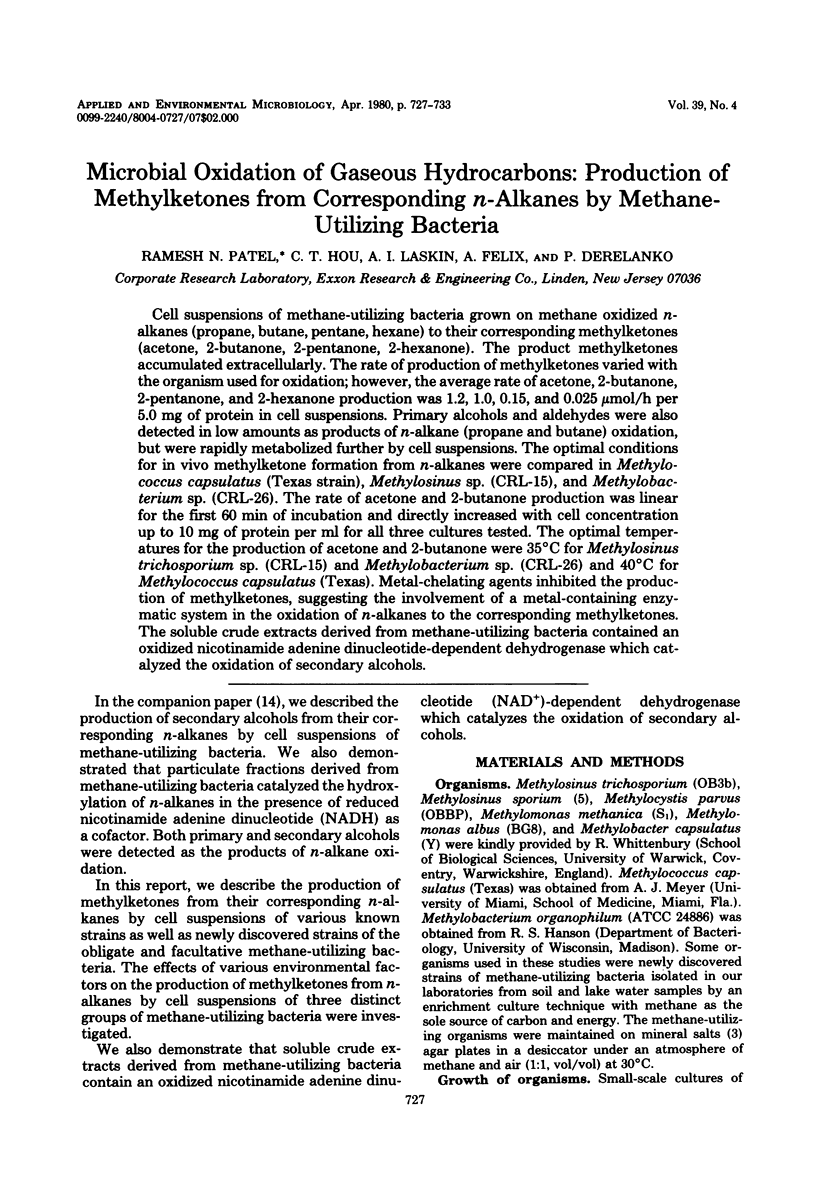
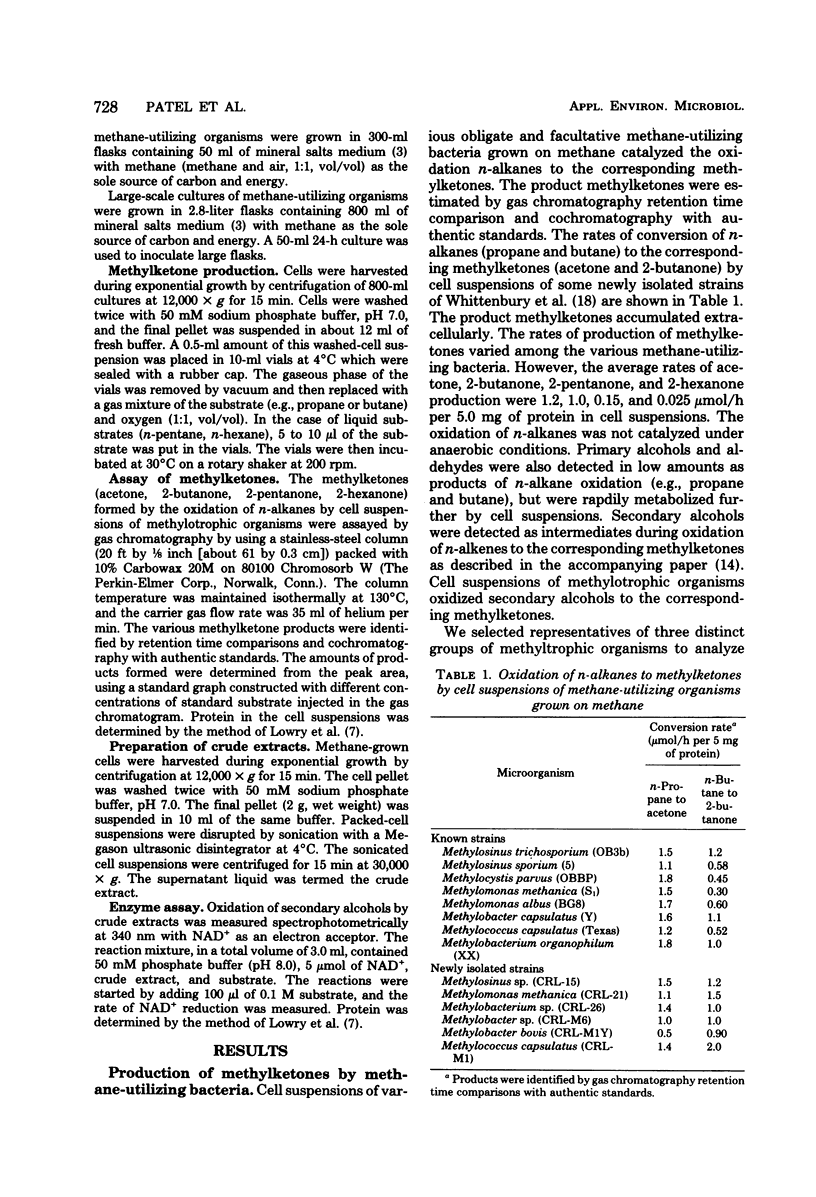
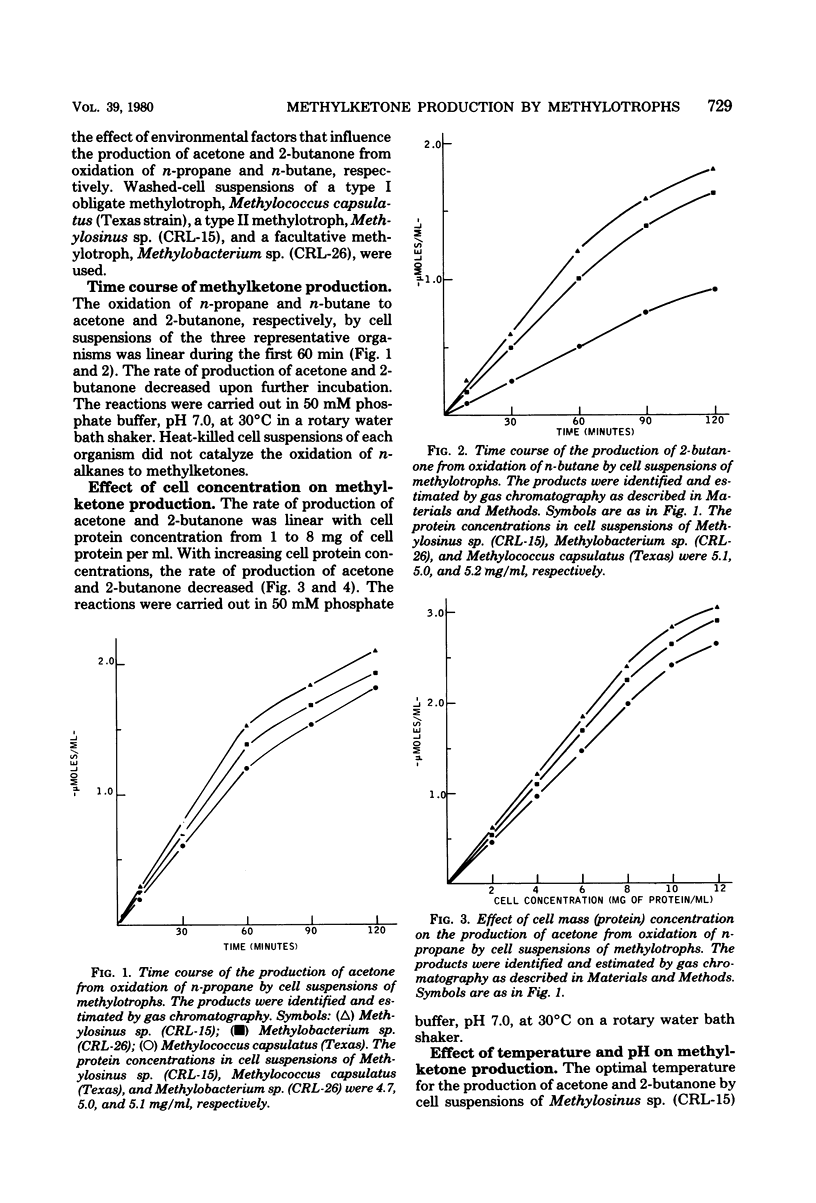

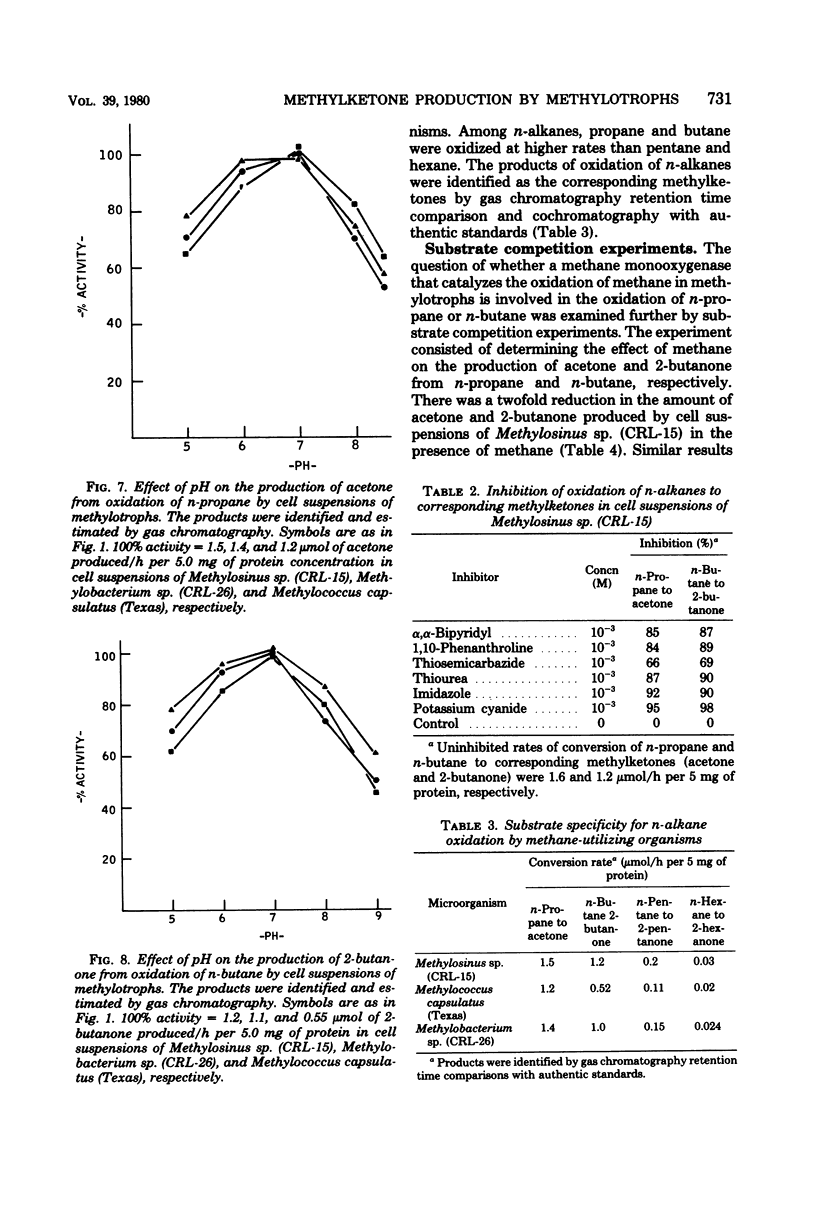
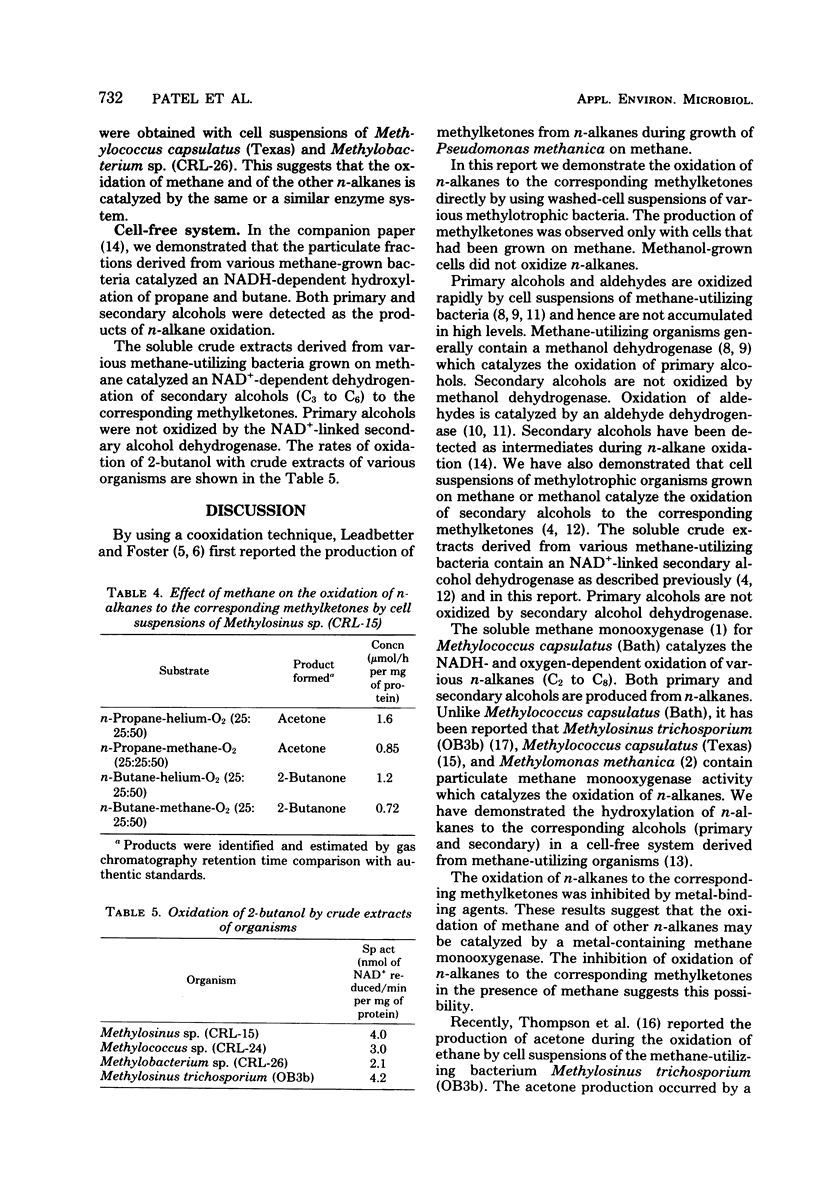
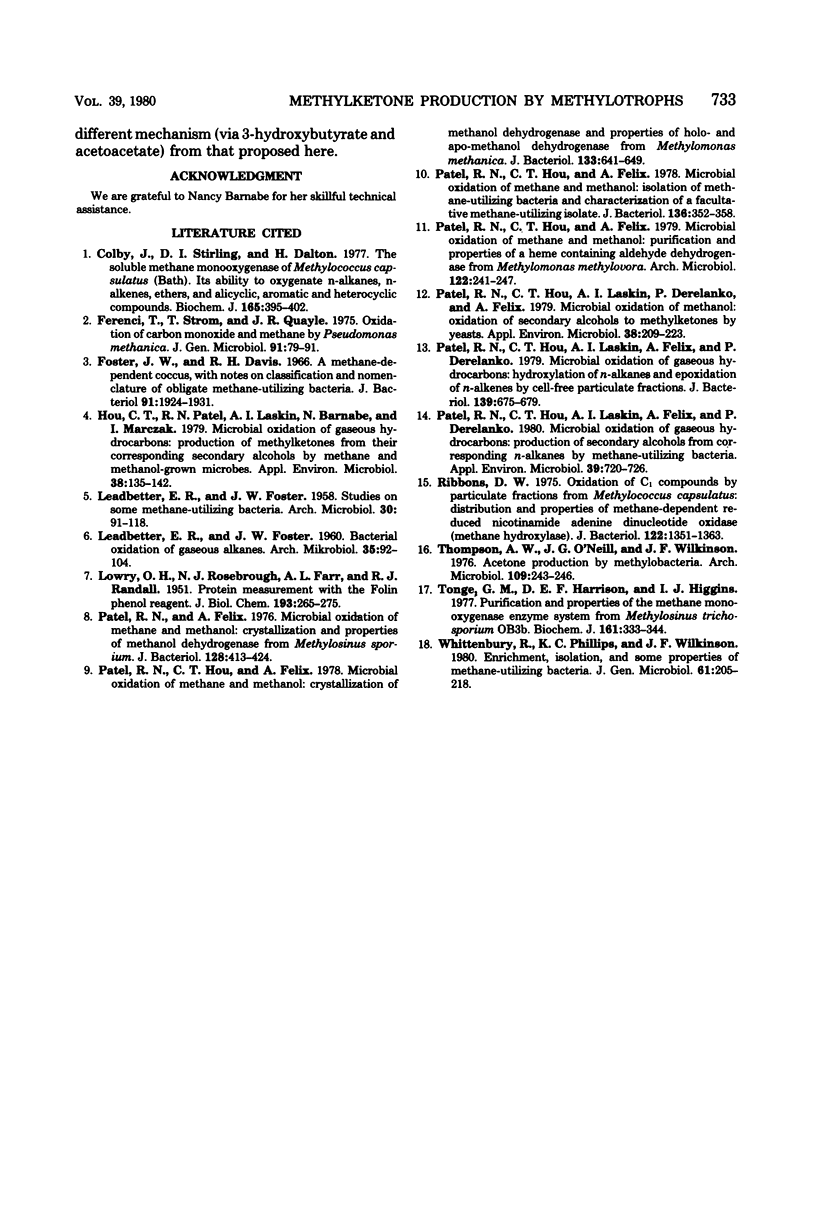
Selected References
These references are in PubMed. This may not be the complete list of references from this article.
- Colby J., Stirling D. I., Dalton H. The soluble methane mono-oxygenase of Methylococcus capsulatus (Bath). Its ability to oxygenate n-alkanes, n-alkenes, ethers, and alicyclic, aromatic and heterocyclic compounds. Biochem J. 1977 Aug 1;165(2):395–402. doi: 10.1042/bj1650395. [DOI] [PMC free article] [PubMed] [Google Scholar]
- Ferenci T., Strom T., Quayle J. R. Oxidation of carbon monoxide and methane by Pseudomonas methanica. J Gen Microbiol. 1975 Nov;91(1):79–91. doi: 10.1099/00221287-91-1-79. [DOI] [PubMed] [Google Scholar]
- Foster J. W., Davis R. H. A methane-dependent coccus, with notes on classification and nomenclature of obligate, methane-utilizing bacteria. J Bacteriol. 1966 May;91(5):1924–1931. doi: 10.1128/jb.91.5.1924-1931.1966. [DOI] [PMC free article] [PubMed] [Google Scholar]
- Hou C. T., Patel R., Laskin A. I., Barnabe N., Marczak I. Microbial oxidation of gaseous hydrocarbons: production of methyl ketones from their corresponding secondary alcohols by methane- and methanol-grown microbes. Appl Environ Microbiol. 1979 Jul;38(1):135–142. doi: 10.1128/aem.38.1.135-142.1979. [DOI] [PMC free article] [PubMed] [Google Scholar]
- LEADBETTER E. R., FOSTER J. W. Bacterial oxidation of gaseous alkanes. Arch Mikrobiol. 1960;35:92–104. doi: 10.1007/BF00425597. [DOI] [PubMed] [Google Scholar]
- LEADBETTER E. R., FOSTER J. W. Studies on some methane-utilizing bacteria. Arch Mikrobiol. 1958;30(1):91–118. doi: 10.1007/BF00509229. [DOI] [PubMed] [Google Scholar]
- LOWRY O. H., ROSEBROUGH N. J., FARR A. L., RANDALL R. J. Protein measurement with the Folin phenol reagent. J Biol Chem. 1951 Nov;193(1):265–275. [PubMed] [Google Scholar]
- Patel R. N., Felix A. Microbial oxidation of methane and methanol: crystallization and properties of methanol dehydrogenase from Methylosinus sporium. J Bacteriol. 1976 Oct;128(1):413–424. doi: 10.1128/jb.128.1.413-424.1976. [DOI] [PMC free article] [PubMed] [Google Scholar]
- Patel R. N., Hou C. T., Felix A. Microbial oxidation of methane and methanol: crystallization of methanol dehydrogenase and properties of holo- and apomethanol dehydrogenase from Methylomonas methanica. J Bacteriol. 1978 Feb;133(2):641–649. doi: 10.1128/jb.133.2.641-649.1978. [DOI] [PMC free article] [PubMed] [Google Scholar]
- Patel R. N., Hou C. T., Felix A. Microbial oxidation of methane and methanol: isolation of methane-utilizing bacteria and characterization of a facultative methane-utilizing isolate. J Bacteriol. 1978 Oct;136(1):352–358. doi: 10.1128/jb.136.1.352-358.1978. [DOI] [PMC free article] [PubMed] [Google Scholar]
- Patel R. N., Hou C. T., Felix A. Microbial oxidation of methane and methanol: purification and properties of a heme-containing aldehyde dehydrogenase from Methylomonas methylovora. Arch Microbiol. 1979 Sep;122(3):241–247. doi: 10.1007/BF00411286. [DOI] [PubMed] [Google Scholar]
- Patel R. N., Hou C. T., Laskin A. I., Derelanko P., Felix A. Oxidation of secondary alcohols to methyl ketones by yeasts. Appl Environ Microbiol. 1979 Aug;38(2):219–223. doi: 10.1128/aem.38.2.219-223.1979. [DOI] [PMC free article] [PubMed] [Google Scholar]
- Patel R. N., Hou C. T., Laskin A. I., Felix A., Derelanko P. Microbial Oxidation of Gaseous Hydrocarbons: Production of Secondary Alcohols from Corresponding n-Alkanes by Methane-Utilizing Bacteria. Appl Environ Microbiol. 1980 Apr;39(4):720–726. doi: 10.1128/aem.39.4.720-726.1980. [DOI] [PMC free article] [PubMed] [Google Scholar]
- Patel R. N., Hou C. T., Laskin A. I., Felix A., Derelanko P. Microbial oxidation of gaseous hydrocarbons. II. Hydroxylation of alkanes and epoxidation of alkenes by cell-free particulate fractions of methane-utilizing bacteria. J Bacteriol. 1979 Aug;139(2):675–679. doi: 10.1128/jb.139.2.675-679.1979. [DOI] [PMC free article] [PubMed] [Google Scholar]
- Ribbons D. W. Oxidation of C1 Compounds by Particulate fractions from Methylococcus capsulatus: distribution and properties of methane-dependent reduced nicotinamide adenine dinucleotide oxidase (methane hydroxylase). J Bacteriol. 1975 Jun;122(3):1351–1363. doi: 10.1128/jb.122.3.1351-1363.1975. [DOI] [PMC free article] [PubMed] [Google Scholar]
- Thomson A. W., O'Neill J. G., Wilkinson J. F. Acetone production by methylobacteria. Arch Microbiol. 1976 Sep 1;109(3):243–246. doi: 10.1007/BF00446635. [DOI] [PubMed] [Google Scholar]
- Tonge G. M., Harrison D. E., Higgins I. J. Purification and properties of the methane mono-oxygenase enzyme system from Methylosinus trichosporium OB3b. Biochem J. 1977 Feb 1;161(2):333–344. doi: 10.1042/bj1610333. [DOI] [PMC free article] [PubMed] [Google Scholar]
- Whittenbury R., Phillips K. C., Wilkinson J. F. Enrichment, isolation and some properties of methane-utilizing bacteria. J Gen Microbiol. 1970 May;61(2):205–218. doi: 10.1099/00221287-61-2-205. [DOI] [PubMed] [Google Scholar]


